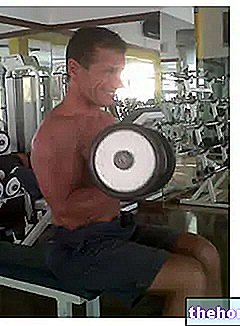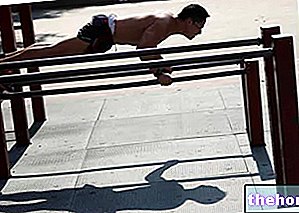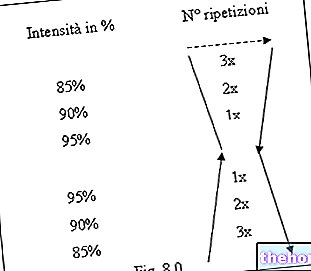Let's face it, how many of you applying the infrequent (in my opinion, exaggeratedly) methods so much advertised ...:
- ... then the muscles were found constantly (or almost) empty?
- ... have they lost confidence with that "pumping" feeling so common when workouts were more frequent?
- ... they have lost the meaning of muscular endurance ... in the sense that the first series is good or bad you manage to do it, but then there is a real vertical collapse in performance?
If you have found the above, and I am convinced that there are many of you, have you ever thought that perhaps the methodologies you were applying "lacked" something?
Well, if on the one hand it is true that the workouts must be particularly intense to "trigger" the processes of muscle growth and that it takes several days to repair the damaged muscle tissue ... on the other hand it is necessary to realize that the excessive infrequency of training may not agree (Zaccone, 2001) with muscle growth.
Why is this statement so in contrast with certain current "fashions"? For example, because a short period of inactivity according to studies carried out by Tidball et al. could significantly reduce the production of nitric oxide (NO), a muscle neurotransmitter important for the activation of its sarcomeres (Koh and Tidball 1999). According to Anderson, in fact, hypertrophy could be delayed by an experimental inhibition of monoxide. nitrogen produced in the muscle.
This should suggest that the placement of a greater stimulus (load of the working session) should be inserted when the previous supercompensation can be considered completely occurred, but being careful not to fall into decompensation.

It should be emphasized, however, that the times of manifestation of biological adaptations are different depending on the type of adaptation we are going to consider.
Some have fairly short supercompensation times, while others manifest themselves significantly even after many days. This dynamic is defined as HETEROCHRONISM and its knowledge is fundamental for the planning of training.
It follows that the workloads, between the various sessions, must be gradually and progressively increased, but alternated with precise regeneration phases, in which the load must decrease. It is in these periods that organic adaptation takes place, that is to say the establishment of those mechanisms that compensate for the work carried out by increasing the functional reserves and predisposing the biological system to a tougher commitment.
This type of distribution of the stimulus-adaptation binomial must therefore take place through a "cyclical organization to guarantee the repetition of the stimulus in useful times to exploit supercompensation.
This is done by linking the workload of each individual session, in a rational way with that of the next session, in order to rationalize the process of construction of what is the so-called microcycle of training, that is to say, that relatively short period (generally lasting 5-10 days) within which the workouts are articulated.
A really productive way to structure a training schedule is what I personally dubbed "cross intensity disposition".
In practice it is a question of training in the same table of the muscle sections in two ways: one heavy and one light. A "twin" table must then correspond to this table in which the muscle sections will be trained in an inverted manner.
effective
the min. sets)
on a bench inclined at 60 °
effective
the sets (min.)
effective
the sets (min.)
slightly declined bench
effective
the sets (min.)
to obtain the Mesocycle repeat for 3-5 weeks
Note:
- The consecutive exercises, denoted by the same letter (A1 and A2) must be performed in a cycle (like a superset, but with rest in between);
- On some days the exercises will be performed in a heavy way (pushing to imitate and inserting intensity techniques), while on other days the exercises will be performed lightly with medium-high repetitions and not bringing the series to the limit.
- Stripping (6 + 6 + 6), to be used only in the last series of the exercise, is done by climbing - without rest between the sets - from time to time the weight of 20%
- Explosive execution in the contraction (about 2 seconds) and slow in the negative (about 4 seconds).
- The rest times indicated refer to the training series; for those of warm-up - between one series and the other - you can rest less.
- In the training series it is necessary to perform the maximum number of repetitions possible: those shown are only indicative.
- Apply the principle of progressive load: when in the first set of a given exercise, more repetitions than indicated in the corresponding interval are possible, in the following workout increase the weight by 5-10%
The structure of the cross-intensity tables may - at a not too keen glance - seem elementary, but it is extremely productive. I wanted to clarify it because some time ago, a student of mine whose technical training (he is ... er ... an instructor ...) originates from a trend that I would personally define "more sensationalist smoke than roast... ", analyzing (so to speak ...) the scheme, he was unable to externalize anything else (from the series:"it is better to keep quiet and give the impression of being stupid than to open your mouth and be sure... ") that the following words: "but this is an old stripping table... ", not even remotely sensing the background that is behind it ... but I do not expect that in certain corporations they understand such subtleties ...


Francesco Currò, ASI / CONI teacher, teacher of the "Academy of Fitness, athletic trainer and personal trainer, is the author of the new book"Full Body", of the" e-book "The Training"and of the book on" Multiple Frequency Systems ". For more information you can write to the email address [email protected], visit the websites http://web.infinito.it/utenti/x/x_shadow/ or http: //digilander.libero.it/francescocurro/ or call the following number: 349 / 23.333.23.
Bibliography:
Prof. Giacomo Zaccone - "Muscle growth and transformation: new frontiers of molecular biology" - Physical Culture and Fitness n ° 358 p. 61-67
Accademia del Fitness - Handout relating to the first level course for Body-Building instructors
Francesco Currò - "The multiple frequency system", RED 2002 Editions
Francesco Currò - "Training" technical handout
Dr. Alessandro Gelli - "How to get a strong, beautiful and healthy body, in the" intimacy of your home "




























